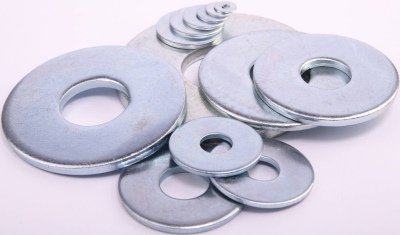Description and purpose
When working with fasteners, a number of difficulties arise from time to time, which were solved only with the advent of washers. With a small metal flat disc with a hole in the center, the technician can avoid:
- spontaneous unwinding of parts;
- damage in the process of screwing fasteners;
- insufficient tight fixation of a bolt, screw or self-tapping screw.
Despite the simplicity of the design, it is the washer that makes it possible to increase the clamping surface, and in some cases to make the connection of parts more dense. Due to the breadth of application of this product, manufacturers have taken care that the diameter of the inner hole is different.
Flat washers can be made of various materials, but their quality remains unchanged, which is controlled by GOST 11371-78. On sale you can find this product in two versions:
- no chamfer - the washer has the same width of the entire surface;
- with a chamfer - there is a bevel of 40 ° to the edge of the product.
Depending on the application, you can choose between simple washers or reinforced washers that can withstand heavy loads. This option is successfully used in light and heavy industry. The most popular uses for washers are:
- shipbuilding;
- mechanical engineering;
- assembly of agricultural machinery;
- production of machine tools for various purposes;
- construction of oil mills;
- work with refrigeration equipment;
- furniture industry.
To understand what washers are needed for what, it is important to know the technical characteristics of each product option.
Washers material and features
Reinforced washers are made of various materials. The most commonly used galvanized structural steel. They can also be made from carbon and mild steel, stainless steel, brass, copper, aluminum, non-ferrous alloys and plastic. Hot and galvanized zinc coating, chemical oxidation, yellow chromating are used. The washer can meet various GOST and DIN standards. The most widespread flat washer is enlarged DIN 9021. Most often it is made of stainless steel A2 or acid-resistant austenitic steel A4. Also, hardware of this type, made of galvanized steel S1008, is quite common. Other types of reinforced or oversized washers are produced according to DIN 440, 1440, 1052, 6340, 7349, 7989. DIN 440 and 1052 washers are most widely used in woodworking and furniture production, 7349 is used with bolts with heavy spring pins, 7989 - for joining steel structures. Washer hardened standard 6340 is made of high-strength alloy steel and is used for increased loads.
Materials (edit)
Various types of metals can be used to make enlarged fasteners of this type.
Steel. A carbon, alloy and corrosion resistant steel base is a suitable option for making washers. This material is considered the most durable and reliable, in addition, it does not corrode. As a rule, in the manufacturing process, fasteners are additionally coated with a special galvanized coating, which provides better protection of the washer from mechanical stress, improves its reliability and durability. Galvanized steel is absolutely safe from an environmental point of view.
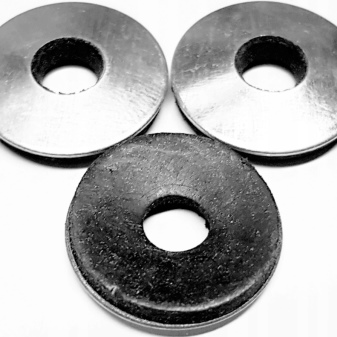
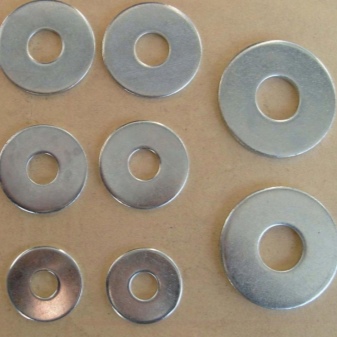
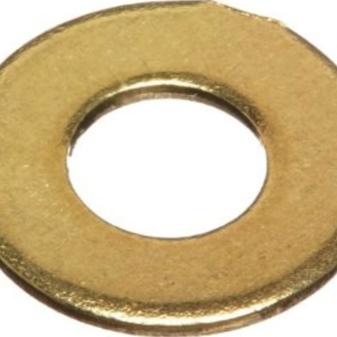

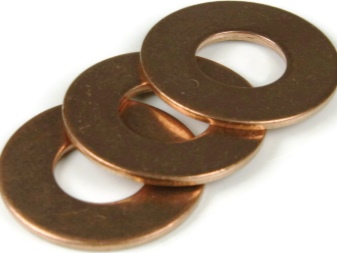
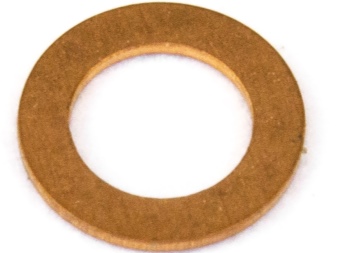

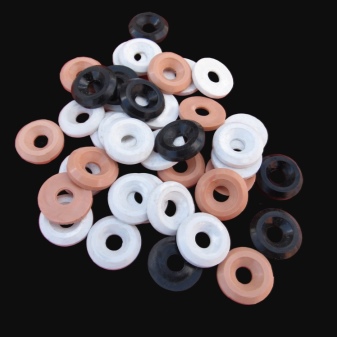
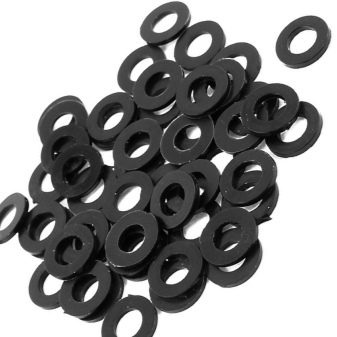
Materials (edit)
Various materials can be used for the production of washers. The most demanded are:
- carbon steel;
- alloy steel;
- stainless steel;
- brass;
- copper;
- plastic;
- wood;
- cardboard;
- rubber.
The coated steel washer, as well as galvanized varieties, are the most demanded parts, as they have good strength and resistance to various influences. Plastic options are considered a good alternative, as there is no need for additional processing during the production process.
By using different materials, you can select parts for different areas and achieve the best result.
Features of production
To obtain flat washers, you can use bar or sheet material, which is sharpened with the necessary tools. In the process of creating products, they can undergo heat treatment, which ultimately gives stronger and more reliable parts. The best option is considered to be materials on which a protective layer has been applied - their service life is much longer. One of the important points is the galvanizing procedure, which can be carried out in two ways.
Electroplated - a thin layer of zinc is applied to the washers due to the action of a chemical substance, which makes it possible to obtain a smooth product with an even coating.
If we are talking about aluminum washers, then they are treated with yellow chromating, which prevents the metal from deteriorating under the influence of corrosion. For best results, the washer blanks are washed, then etched, washed again and chrome applied, and then washed again.
Installation rules
In order for the washer to be able to provide the most reliable and strong fixation, it is necessary to install it correctly. First you need to calculate that the diameter of the outer part is equal to the diameter of the inner part, which has been multiplied by three. During the installation process, the washer with an increased field is tightly fixed in the place between the mount and the part that will be connected. After that, it is necessary to tighten the entire fastening structure with effort.
When installing, it is worth remembering the following important nuances:
- do not forget, when it is possible to create a bolted connection on a soft surface, it is still better to use a reinforced washer, since it is such fasteners that will allow you to form a large supporting area;
- the increased support area makes it possible to evenly distribute all the pressure that has arisen on the surface, this makes the connecting structure more durable and resistant;
- if during the installation process you screw a nut, then it is better to use such a washer as an additional protective element, because when installing the nuts, there is a lot of friction, which can lead to surface damage; an enlarged washer in this case will help prevent scratches and other damage to the structure.
The following video describes the installation of oversized washers.
Varieties
The appearance of washers made it possible to be confident in fasteners using self-tapping screws and screws, therefore these products are widely used in various industries. Due to its great popularity, many varieties of this part have appeared:
locking - have teeth or legs, thanks to which they allow fixing fasteners, preventing them from spinning;
If we consider the variety of washers in more detail, you can notice a difference in some criteria:
- diameter - external indicators of diameter are usually not so important, and internal dimensions can have the following dimensions: 2, 3, 4, 5, 6, 8, 10, 12, 14, 16, 18, 20, 22, 24, 27, 30 , 36 mm and more;
- width of fields - washers are divided into wide and narrow varieties;
- shape - flat variety, corresponds to GOST 11371 or DIN 125, this option is the most common; flat increased corresponds to GOST 6958 or DIN 9021, this is a reinforced washer due to longer fields; grower room complies with GOST 6402 or DIN 127, also called spring; quick-release locking device conforms to DIN 6799; square washers, which can be wedge-shaped, corresponding to GOST 10906-78, or square for wooden products, corresponding to DIN 436.
All normal washers must meet quality requirements, therefore, for most of them, GOSTs are provided
There are quite a lot of washer options, and the number can be replenished, therefore it is important to study the classifications and correctly select additional products for fasteners
Features and purpose
The oversized washer is a standard flat fastener that has a large outer diameter and thickness. Basic information about such parts can be found in GOST 6958-78. It describes the design of these washers, their dimensions, weight, and technical requirements. In addition, many requirements for the quality and manufacturing process of such elements are listed in the special standard din 9021. Unlike the standard flat model, which has an outer diameter slightly larger than the diameter of a bolt or nut, reinforced fasteners are large and heavy. The ratio of the diameters of the outer and inner parts for the enlarged views is 1: 3. These parts are most often not used as a separate fixture, they are used as an auxiliary fastener.
Oversized washers can be made from different materials. The most popular option is considered to be models made from a steel base. The diameter of such samples most often varies from 12 to 48 millimeters, although models with a lower indicator are currently sold. These types of fasteners, as a rule, belong to the accuracy class A or C. The first type belongs to the group of increased accuracy levels. Models related to it have a larger diameter value compared to group C.
Reinforced models will be the best option for bolting, because they contribute to the most even distribution of the total load over a large area. As a result, the pressure on the supporting surface is reduced, the reliability and safety of the finished structure is ensured. Sometimes these parts are used together with studs, spring elements, nuts. Such washers should be purchased if you are going to work with thin, fragile or soft materials, since in these cases it is not always possible to take other fasteners, including bolts.
All washers have their own specific geometric meanings. These include the indicator of the inner and outer diameter, as well as the thickness. Fasteners are marked according to the metric diameter of the structure
Before purchasing a suitable set with reinforced washers, make sure that their surface is not scratched, chipped or otherwise damaged.
